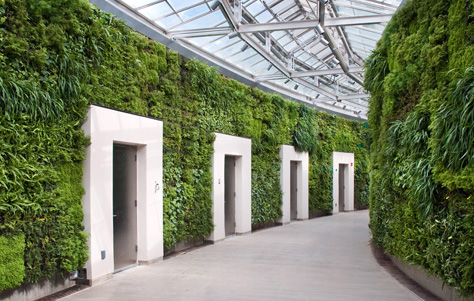Well this isn't how I thought I spend my Monday morning but I'm well intrigued by all this. My partner is a plant-lady, I reckon I could sell her on a green-wall. My landlord however...
You can build 'em freestanding. Any discussion of green walls invariably makes its way back to Patrick Blanc, who basically came up with the idea. His implementation is "fixture covered with soil that is retained somehow" which in the US, generally means a heinous combination of greenboard, burlap and dirt. The professional version of this is a little fancier but still basically "trap a bunch of dirt next to your wall and grow stuff in it." There are residential solutions for this. Credit where credit is due - the first one I ever saw was Siam Paragon, which is one of Blanc's. The drawback of "wall with dirt" is that if a plant dies, you get to go dig it out. And you get to replace it. In amongst all the other plants. On your carpet. Or whatever. Picking plants becomes hella more important when you basically have to tear up the world. If they get to big, you have to tear up the world. If they get blight, you have to tear up the world. Green walls got a reputation as fiddly and fussy. And then GSky stepped in. GSky figured out that the plants are already in dirt and really, if you can put pots on a wall the world gets a lot easier. They came up with a system whereby you put pots in at an angle, water the top, and everything fills up to the point where part of the pot is sitting in an inch of water, and then the water trickles down below. Here's mine without plants. They used to sell that to end-users in a housing. I had to buy two and a half of them, basically. They're expensive - each one of those trays is about $100 worth. And then you have to buy the plants (in this case, 196 of them). I think that's about a $2800 green wall. The argument was that it was going to be way less work and way more on-brand than the ubiquitous marine tank and it's been a total win so far. This is why GSky can charge what they do - they have a patent and they have something ridiculous like 80% of all the installed green walls in the world (so much for Mr. Blanc). Which is exactly the sort of thing that attracts the attention of the Chinese.

Thanks for writing it all out - I was thinking about some kind of angled-pot mechanics as I was picturing having to replace just one and what work that might entail. Good to know I was vaguely heading in the right direction. The upside is this might not be necessary for me, no issue with space where I live and I imagine these sprung up to combat that issue. I do like the aesthetic though. I was watching that Planet Earth 2 Doco and was transfixed by the Singapore man-made trees. I had seen pictures of them before and I honestly thought they were a sci-fi concept art thing for a bit. Like, fuck that's cool. No idea if it's doing what they intended, but it's cool.
There's this whole pseudo-specialty called "biophilic design." I'm no expert and I haven't dug around too much but it basically seems to be the science of "plants are cool." Green walls started from a basis of "plants are cool" and then there was some science reverse-engineered into it in order to crack money loose. Designers like Ken Yeang cover their buildings in plants 'cuz it's dope and if they can back into some science so much the better. That, I believe, is the justification for the Singapore trees - they look fuckin' cool and Malaysia has been pushing hard into green design so Singapore jumped on, too. I love the aesthetic. I put up a green wall not because I wanted an air filter but because they look cool. That Boston Fern hanging above the bar is not doing as good a job of making the air breathable as a Smokeeter but a live one is helping more than a silk one.